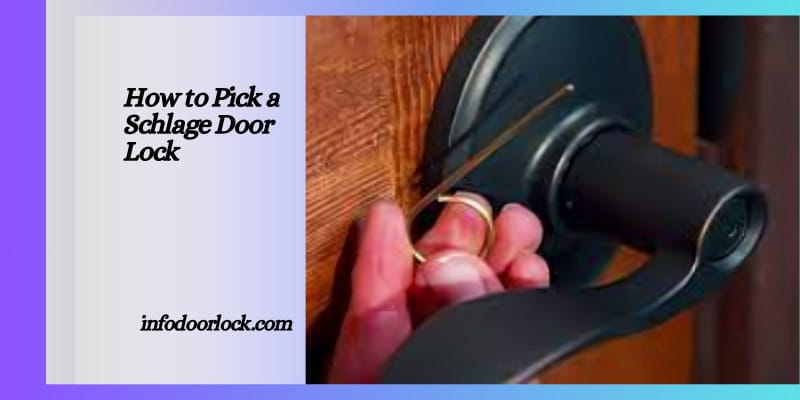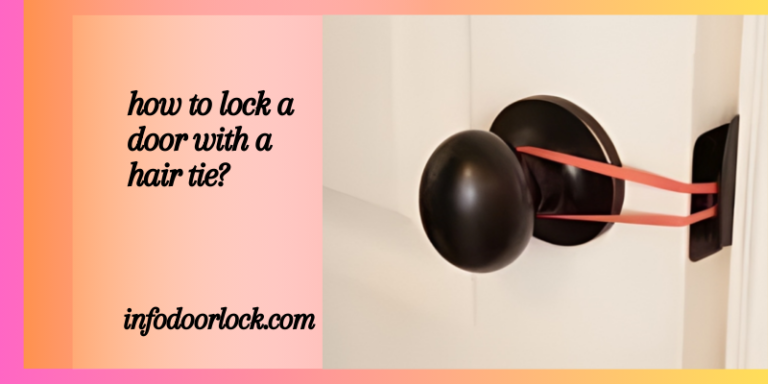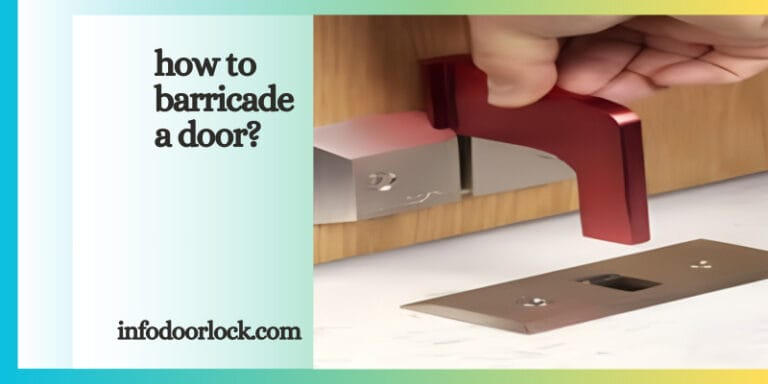How to Pick a Schlage Door Lock: A Step-by-Step Guide
When it comes to securing our homes and places of work, the choice of lock emblem is paramount, and Schlage stands out as a beacon of reliability and innovation inside the enterprise. With a legacy spanning over a century, Schlage has cemented its popularity by offering a huge range of exceptional locks that cater to the various desires of safety-aware individuals.
Their dedication to excellence guarantees that when you choose a Schlage lock, you are not just shopping for a product; you are also making an investment in peace of mind.
However, even the most dependable lock can come to be a surprising hurdle in situations like misplacing your keys or coping with a malfunctioning lock mechanism. How to Pick a Schlage Door Lock a simple knowledge of how to select a lock can turn a capability crisis into a doable situation, ensuring you’re in no way left stranded outside your private home or office.

It’s crucial to approach the subject of lock selection with a clear understanding of the ethical and felony implications. Lock selection ought to most effectively be undertaken in conditions where you have express permission to unencumbered the door, ideally on a lock that you very own. How to Pick a Schlage Door Lock for informational purposes and to help you in emergency situations involving your property. Always respect privacy, possession, and nearby legal guidelines while applying the talents discussed in this guide.
Remember, with notable strength comes brilliant obligation, and using those abilities unlawfully can result in legal repercussions and undermine belief in the locksmithing network. With this in mind, let’s delve into the necessities of selecting a Schlage door lock, geared up with the right gear, strategies, and a respectful know-how of the art and technological know-how at the back of lock selection.
Tools You Will Need for Picking a Schlage Lock
- Equipping yourself with the right equipment is the first step to effectively choosing a Schlage lock. Schlage locks are recognised for their robustness and safety features, so having a hard and fast choice of wonderful lock choosing equipment can make all the difference.
- Below is a curated list of critical tools you’ll need, together with a brief assessment of each tool’s cause, to help you navigate this complex task with precision and ease.
1. Tension Wrench
Purpose:
- The tension wrench, often called a torque wrench, is arguably the most critical tool in your lock choosing arsenal.
- Its number one role is to apply tension to the lock’s plug (the part that turns with the key) at the same time as you figure out how to put the pins in with your pick.
- Proper use of the tension wrench allows you to imitate the action of turning the key, which is important for effectively selecting the lock.
2. Pick Tools
Standard Pick:
- This tool is your primary tool for manipulating the pins in the lock. It comes in diverse shapes, which include the hook, half-diamond, and rake, each suitable for special picking strategies or lock kinds.
Hook Pick:
- Ideal for single-pin selecting, permitting specific control over individual pins.
Half-Diamond Pick:
- Versatile for unmarried-pin picking or raking, useful for each feeling the pins and scrubbing over them.
Rake Pick:
- Designed for a speedy scrubbing method, it is effective for quicker, much less particular manipulation of pin stacks.
3. Bump Key (Optional)
Purpose:
- While no longer a conventional lock choosing tool, a bump key may be specifically effective on pin tumbler locks like the ones made via Schlage.
- It works by placing an especially reduced key into the lock, after which, using a bump hammer or every other tool to ‘bump’ it, it inflicts the pins to leap to their shear line momentarily, permitting the lock to show.
- This technique requires practice and isn’t always as diffused as conventional selecting, but it may be powerful in certain conditions.
4. Lock Picking Practice Lock (Optional)
Purpose:
- Before attempting to pick an actual Schlage lock, it might be useful to practice on a clean or cutaway practice lock. These training gear let you see the inner workings of the lock mechanism, providing valuable perception into the results of your manipulation on the pins.
- Equipping yourself with this gear and understanding its unique purposes will no longer only enhance your lock picking abilities but additionally significantly increase your possibilities of correctly How to Pick a Schlage door lock. Remember, practice makes perfect, and it’s crucial to hone your competencies within the bounds of the regulations and moral requirements.
Understanding the Lock Mechanism
- To end up proficient in choosing Schlage locks, it is critical to understand how their pin tumbler mechanism operates. A typical Schlage lock carries numerous key additives: the plug (the component that turns with the important thing), the pins (comprising key pins and motive force pins), and the springs that push the pins downwards.
- When the suitable key’s inserted, it lifts the important thing pins to a specific height, aligning the motive force pins at the shear line, the gap between the plug and the lock body, and allowing the plug to turn and release.
- Understanding this mechanism is pivotal because a hit lock selection hinges on your potential to manipulate these pins to the shear line without the important thing. Each pin has to be set at the right height, mimicking the secret of motion.
- This understanding not only demystifies the lock’s inner workings but additionally informs your method, bearing in mind a more strategic and powerful technique for picking.

Step-by-Step Guide to Picking a Schlage Door Lock
Preparation
- Before diving into the chosen method, ensure you have the necessary gear laid out and a smooth, properly-lit workspace.
- Familiarize yourself with your tools, mainly the texture and characteristics of every pick and the anxiety wrench.
- This preparatory step is crucial for a smooth and green picking experience.
Inserting the Tension Wrench
- Start by inserting the tension wrench into a part of the keyhole in the identical location where the secret’s flat side might pass.
- Apply a gentle, constant force in the course the key might flip to unencumbered the door.
- This anxiety is important as it will motivate the binding pin to bind first, supplying comments as you pick them out.
Locating the Binding Pin
- With the tension wrench in place, use your pick to probe every pin by gently lifting them. The binding pin will feel stiffer as compared to the others.
- Identifying the binding pin is a skill that has evolved over time, requiring nuanced contact and keen attention to the comments every pin offers.
Picking the Pins
- Once you have positioned the binding pin, follow mild upward stress together with your select until you feel or hear a slight click, indicating the pin has reached the shear line.
- Maintain the tension at the wrench at the same time as you flow to the subsequent binding pin.
- Repeat this process, moving from one binding pin to the next, putting everyone on the shear line.
Turning the Cylinder
- After all pins are set on the shear line, the plug will rotate freely, as in case you used the suitable key. At this factor, maintain your tension at the wrench and gently flip it fully to unlock the door.
- This step calls for a sensitive balance of preserving the tension carried out at the same time as not forcing the wrench, as excessive force can reset the pins or damage the lock.
- Successfully selecting a Schlage lock requires a blend of finesse, staying power, and exercise. Each lock is precise, and the texture of each pin setting can vary.
- As you refine your method, you’ll expand a deeper instinct for every step of the system, improving your capability to address a variety of Schlage locks successfully.
- Remember, exercise responsibly and ethically, making sure you’ve got permission to pick out the lock and that it is for a legitimate cause.
Tips and Tricks for Beginners in Lock Picking
- Lock choosing is an ability that requires endurance, precision, and practice. As a beginner, it’s easy to fall into common pitfalls that can restrict your progress.
- Here are a few pointers and hints to help you navigate the getting to know curve and beautify your lockpicking talents.

Avoiding Common Pitfalls
Excessive Force:
- One of the most common errors is applying too much pressure, both with the tension wrench and the selector.
- This can result in bent equipment, broken pins, or a locked-up mechanism. Always use light, controlled pressure comparable to the contact of a feather.
Overlooking the Feel:
- Lockpicking is significantly more about touch than it is about strategy. Observe carefully the feedback that each pin provides through your gear.
- This tactile reaction is essential for recognizing binding pins and comprehending the purpose of a pin.
Lack of patience:
- Rushing the process can lead to mistakes. Take your time with each pin, and don’t let failures deter you.
- Every lock presents a fresh challenge and a chance to hone your skills.
Maintaining Patience and Precision
Start Simple:
- Begin with simpler locks and progress step by step to more complicated ones. This sluggish approach builds your skills and self belief.
Practice Regularly:
- Regular exercise is prime for growing your lock choosing abilities. Dedicate time to exercise and be an affected person along with your development.
Stay Organized:
- Keep your equipment prepared and in appropriate condition. This now not only facilitates retaining precision but also develops a scientific technique for lockpicking.
Legal and Ethical Considerations
Lockpicking is a treasured skill, but it comes with a large felony and moral duties. Misuse of lock selecting tools can cause felony results and ethical dilemmas. Here are some pointers to make certain you are practicing lock selection responsibly:
Legal Implications
Permission is Paramount:
- Never attempt to choose a lock that you do not own or have explicit permission to select. Unauthorized lock selection may take into consideration breaking and entering or vandalism, both of which carry prison consequences.
Know the law:
- Familiarize yourself with neighborhood legal guidelines regarding lockpicking tools and their ownership.
- Laws vary extensively by location, and what is criminal in one region might be unlawful in another.
Ethical Considerations
Respect privacy and property:
Always admire others’ privateness and property. Use your skills for valid purposes, such as unlocking your door or providing expert service with consent.
Promote positive use:
- Encourage and exercise the ethical use of lock selecting talents. Share your know-how with the network in a manner that promotes security, knowledge, and accountable use.
- Lock choosing isn’t always just about the technical abilities but also about understanding and respecting the felony and ethical obstacles that include it.
- By drawing a close lock and selecting with persistence, precision, and a sturdy sense of responsibility, you can enjoy the project and the delight it brings while retaining the highest standards of legality and ethics.
Table:How to pick a Schlage door handle lock?
| Step | Description |
| 1. Gather Your Tools | Ensure you have the necessary lockpicking tools: a tension wrench and a pick set (hooks, rakes, and diamond picks are commonly used). |
| 2. Understand the Lock | Familiarize yourself with the type of Schlage door handle lock you’re dealing with. Most use a pin tumbler mechanism, but some may have additional security features. |
| 3. Insert the Tension Wrench | Place the tension wrench into the bottom part of the keyhole. Apply gentle, consistent pressure in the direction you would turn the key. The amount of tension is crucial; too much can bind the pins too tightly, while too little may not hold the picked pins in place. |
| 4. Identify the Binding Pin | Use your pick to gently probe each pin by lifting them slightly. The binding pin will feel stiffer than the others. This pin is your starting point. |
| 5. Pick the Pins | With the binding pin identified, use your pick to lift it until it sets at the shear line. You should feel a slight give or hear a click. Move on to the next binding pin and repeat the process. Continue until all pins are set. |
| 6. Turn the Cylinder | Once all pins are set, the tension wrench should turn the cylinder as if you were using the key. If it doesn’t turn, there may be a pin that is not properly set. Reassess and adjust your picking as necessary. |
| 7. Open the Door | With the cylinder turned, the lock should disengage, allowing you to open the door. If the door does not open, ensure that the lock is fully disengaged and that there are no additional security features or latches in place. |

Conclusion On How to pick a schlage door knob lock
- In this comprehensive guide, we’ve journeyed through the essentials of picking a Schlage door lock, from knowledge of the complicated pin tumbler mechanism that lies at the coronary heart of most Schlage locks to learning the delicate dance of anxiety and precision required to coax the lock open without the important thing.
- We’ve explored the important tools of the trade, delved right into a step-by way-of-step technique tailored for novices, and highlighted the common pitfalls to avoid. Moreover, we’ve underscored the paramount significance of endurance, precision, and practice in honing your lock-choosing talents.
- Yet, beyond the technical knowledge and the tactile finesse, we have additionally ventured into the ethical and prison frameworks that govern the accountable use of lock selection. It’s a talent set that, while immensely worthwhile and every now and then existence-saving, demands an excessive degree of ethical integrity and criminal awareness.
Encouragement to Practice Responsibly and Legally
- As you embark on or continue your lock-picking journey, let the standards of duty and legality be your guiding stars. Remember, the authentic artistry of lock choice lies no longer simply inside the mechanical manipulation of pins and tumblers but in the respectful and ethical software of the ability.
- Your prowess needs to usually be a testament to your commitment to the usage of these talents for legitimate purposes, along with resolving non-public lockout eventualities or advancing your expert locksmithing capabilities.
Call to Action On How to pick a schlage door knob lock
- We invite you to delve deeper into the world of DIY protection and lockpicking, armed with the knowledge and ethical issues mentioned in this guide. For those moments when the project surpasses your ability level or when you’re confronted with a lock that defies your first-class efforts, do not hesitate to call on the information of a professional locksmith.
- Their intensity of know-how and experience can no longer offer the best solution you need, but they also offer priceless insights into the ever-evolving landscape of lock safety.
- For lovers eager to broaden their knowledge and abilities, we encourage you to explore similarly in the area of DIY security guidelines, where each lock presents a new puzzle and every solution depends on your repertoire of expertise and understanding.
- Whether it’s deepening your sensible abilities, acquiring the latest expertise in the lock era, or contributing to a network of like-minded individuals, the journey of getting to know and increase in no way truly ends.
- Embrace the challenge, practice with integrity, and usually, pick out responsibly.
FAQs on How to Pick a Schlage Door Lock?
1. Is it criminal to select a Schlage door lock?
- The legality of lockpicking depends on your intentions and the laws of your jurisdiction. In preference, it’s a prison to select a lock if you personalize it or have explicit permission from the proprietor. However, the use of these skills on locks you do not own or without permission can be considered illegal and unethical. Always check local laws and rules regarding lock selection in your region.
2. What tools do I need to pick up a Schlage door lock?
- To pick a Schlage door lock, you may generally want an anxiety wrench and a hard and fast lock alternative, which include exceptional kinds of choices like a hook pick, half-diamond pick, and rake select. These pieces of equipment help you practice tension and control the pins within the lock to open it without a key.
3. Can all Schlage locks be picked?
- While many Schlage locks may be picked using conventional lock picking strategies, the organization additionally produces high-safety locks with functions designed to withstand choosing, such as security pins and complex keyways. These excessive-protection models may also require superior talents and specialized gear to pick.
4. How long does it take to choose a Schlage door lock?
- The time it takes to select a Schlage door lock varies extensively depending on the lock model, the picker’s talent degree, and the equipment used. For novices, it would take numerous minutes to efficiently choose a lock, while skilled lockpickers are probably capable of opening the identical lock in a matter of seconds.
5. Can gaining knowledge of choosing a Schlage lock enhance my domestic’s security?
- Yes, getting to know how to select locks, consisting of Schlage locks, can provide valuable insights into how locks work and their vulnerabilities. This knowledge permits you to make knowledgeable choices about the security of your house and choose locks that offer better resistance to picking and different forms of security.







